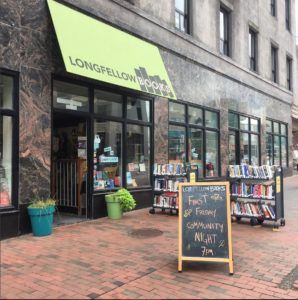Policy matters. Over the last 40 years, however, we’ve made a series of policy decisions that have promoted economic concentration, at the expense of fair competition, independent businesses, and communities. As a result of these decisions, the number of independent businesses has plummeted, income inequality has grown sharply, and whole regions of the country have been left behind. They’ve also resulted in a loss of local power and capacity, as communities are increasingly controlled by outside forces, from Wall Street banks, to agribusiness monopolies, to powerful platforms like Amazon.
It’s time for new policy. There’s an urgent need to overhaul the policies that have fueled concentration, and advance an agenda to restore vitality to places left behind by rebuilding the economic power and capacity of local communities. Along with important steps for the federal government to take, cities and states have a great deal of authority to limit corporate power and grow local businesses.
In the policy guide below, we offer a platform with five planks. To make the U.S. more equitable, dynamic, and locally rooted, we need to: Focus on the built environment, reorganize economic development programs, enable businesses to access the capital they need to start and grow, make the tax code more equitable, and promote fair and open competition. Within each of these five categories, the guide below gets into the details. We offer specific policies to pass at the local, state, and federal levels to achieve these goals, and include examples — with the exact text of the policy — of places that have done just that.
1. Create a Built Environment that Supports Local Businesses
2. Reorganize Economic Development Programs
3. Enable Access to Sufficient Capital
4. Implement an Equitable Tax System
5. Promote Fair and Open Competition
Want more resources like this? Don’t miss our brief on eight policy strategies that cities can use to support local businesses or our Local Policy Action Toolkit for independent businesses with tips on engaging elected officials and advocating for policies that support and strengthen the local economy.
1. Create a Built Environment that Supports Local Businesses

The issues facing independent businesses show up in different ways in different communities. In some places, communities need tools to revitalize downtowns, restore needed services, and fill vacant storefronts. Other communities are grappling with rapid development and investment, and seeking ways to mitigate displacement of local businesses, control the growth of chain stores, and ensure that the benefits of growth are distributed equitably.
While these contexts are different, the strategies to address them overlap. One of the most effective places to start is with the built environment: The buildings, sidewalks, and roads on which local businesses rely, and which communities have a great deal of capacity to shape. Independent businesses tend to thrive in environments that are varied and walkable. To support them, town, city, county, and metro area governments should adopt policies that encourage commercial diversity, ensure that new developments include space appropriate for locally owned businesses, prioritize development that is multi-story and mixed-use, actively favor infill development over sprawl, and create space for walking, biking, and public transit.
How to do it:
Policy tools for the local level:
Adaptive Reuse: Neighborhoods with a variety of building ages tend to provide the type of varied, walkable built environment that’s well-suited to independent businesses, but in many places, historic commercial buildings are vacant or in disrepair. Through adaptive reuse programs, cities can help local entrepreneurs restore these spaces — and at the same time, make whole neighborhoods more dynamic and better connected.
Community Ownership of Commercial Spaces: Facing issues like half-vacant business districts and lack of neighborhood services, some communities are joining together to invest in, develop, or own local businesses themselves, through models like investment cooperatives and community-owned stores.
Comprehensive Plans: As a kind of vision statement that guides future development, comprehensive plans are an important place to articulate a plan to promote small-scale, walkable development and support local entrepreneurship.
Dollar Store Restrictions: As national dollar store chains expand rapidly in urban and rural areas alike, policies developed by cities like Tulsa, Okla., Mesquite, Texas, and Kansas City, Kans., offer communities different ways to restrict these small-box, discount retailers in order to support more balanced, local development. Communities have used zoning techniques like limiting the density of these stores in particular neighborhoods, added “conditional use” requirements in order to open new dollar stores, or initiated broader formula business restrictions.
Dealing with Big-Box Stores: This page is under construction! For now, for policy tools to help deal with big-box stores, see our resources on Store Size Caps, Protecting Chain Retail Workers, Preventing Dark Malls & Vacant Big Boxes, Formula Business Restrictions, Economic Impact Review, Development Moratoriums, and Banning Public Subsidies for Big Retailers.
Economic Impact Review: For communities concerned about large-scale development that favors chain stores, economic impact reviews offer a way to require municipalities to assess the economic and fiscal impacts of developments over a certain size.
Formula Business Restrictions: Used in places ranging from San Francisco, to Jersey City, N.J., to Fredericksburg, Texas, formula businesses policies offer a way to limit chain stores or require that they meet certain conditions to open. At the same time, these policies help make independent businesses more attractive tenants for landlords, give neighborhood residents more of a voice, and ensure that neighborhood business districts remain distinct and community-serving. This policy is as useful in small towns seeking to maintain their character as it is in big cities experiencing an influx of development and investment.
Affordable Commercial Space for Local Businesses: In affluent and low-income neighborhoods alike, rising commercial rents are displacing long-time businesses and raising barriers to entrepreneurship. This page outlines six broad strategies cities can use to address the problem, from supporting business owners that want to buy their space to requiring set-asides for local businesses in new development.
Neighborhood-Serving Zones: In areas that have become an attraction for tourists or travelers, this zoning tool helps ensure that neighborhood residents can continue to access important services like a hardware or grocery store. It works by requiring that new retail stores show that a majority of their sales will come from the surrounding neighborhood.
Set-Asides for Local Businesses: The financing behind commercial real estate development tends to favor national brands and nationally-scaled developers. One consequence of this is that commercial space in new development is often large, uniform, and designed for chains. Public policy has an important role to play in checking these forces. Set-asides, which require developers to create commercial space that meets certain conditions, offer cities a tool to do so.
Store Size Caps: In places experiencing an influx of new development, or extensive redevelopment, store size caps work to sustain small-scale, walkable business districts by prohibiting stores over a certain size in particular areas.
Also see some of our related reporting and presentations:
- Our March 2018 article: “In Cities Around the Country, New Action on Commercial Affordability.”
- Our December 2017 article: “In Jersey City, a Policy Fosters Local Independent Businesses.”
- Our May 2017 presentation: “Watch: How Cities Can Create a Built Environment Where Local Businesses Thrive.”
- Our April 2016 report: Affordable Space: How Rising Commercial Rents Are Threatening Independent Businesses, and What Cities Are Doing About It.
- Our April 2014 article: “Two Big-Box Decisions Show How Smart Planning Policies Protect Good Jobs.”
2. Reorganize Economic Development Programs

Every year, local and state governments spend an estimated $70 billion in tax breaks and other subsidies on large companies in the name of economic development; Walmart and Amazon alone have pocketed an estimated more than $1 billion each in public subsidies to fuel their growth. These giveaways distort competition and tilt the playing field in favor of big businesses at the expense of smaller ones. What’s more, they’ve been shown to be ineffective.
In the St. Louis metro area, for instance, a study commissioned by the region’s local governments found that they had diverted more than $5.8 billion in public tax dollars to subsidize private development over a 20-year period, but that the region had seen virtually no economic growth and the large subsidies had contributed to some local governments’ poor fiscal health. Other research, from the organization Good Jobs First, has found that even in state economic development programs that purport to be open to businesses of any size, the overwhelming share of the subsidy dollars go to large firms. Meanwhile, economic research continues to show that new firms are the leading creators of jobs.
We need to rethink economic development. Local and state governments should sharply reduce the tax breaks and other incentives that they give away to big companies. In cases where governments do use subsidies, the awards should be more transparent and more equitably available. Instead of these handouts, local and state governments should invest in public goods that benefit all employers, like public education, workforce development programs, transit, and infrastructure.
In communities that have been economically marginalized, local and state governments should also consider ways to make targeted public investments. These include procurement policies that give a preference to locally owned businesses and businesses that are owned by women and minority groups, small business development programs, fresh food financing initiatives, and city lending programs.
How to do it:
Policy tools for the local and state levels:
Banning Public Subsidies for Big Business: Instead of awarding large retailers public subsidies in forms like property tax exemptions and sales tax rebates, cities, counties, and states should prohibit the use of tax incentives to fund retail development projects, as Arizona has done in the Phoenix metro area.
Local Purchasing Preferences: Local and state governments can make their purchasing double as economic development that strengthens the local economy by giving a preference to locally owned businesses in their spending decisions.
Pennsylvania Fresh Food Financing Initiative: This program offers one example of how local and state governments can make targeted public investments, particularly in underserved communities. In this case, this initiative, seeded with state funds, provided financing for more than 80 grocery stores in low-income neighborhoods in both urban and rural areas across the state.
Local Economy-Oriented Economic Development: This page is under construction!
Also see some of our related reporting and presentations:
- Our October 2017 op-ed in Vice’s Motherboard: “Amazon’s Uneven Playing Field.”
- Our June 2017 podcast episode: “How Big Businesses Get Big Subsidies (Episode 23).”
- Our October 2015 article: “States Shower Big Companies with Economic Development Incentives, at Small Businesses’ Expense.”
- Our October 2015 article: “Procurement Can Be a Powerful Tool for Local Economies, but Takes More Than a Policy Change to Work.”
3. Enable Access to Sufficient Capital

It’s become increasingly difficult to obtain financing to start and grow a local business. Since 2000, bank lending to large businesses has increased 36 percent, while the volume of small business loans, defined as those under $1 million, has fallen 14 percent. Business loans under $100,000 — the amount an entrepreneur might need to buy equipment or make needed upgrades — have fallen even more, by 33 percent.
A primary factor behind this trend is consolidation in the banking industry. Despite their small size, community banks make the majority of all small business loans. But as big banks have grown to dominate the market, aided by banking policies that favor bigger institutions, local community banks have been squeezed out; Between 2008 and 2015, nearly one in four community banks closed its doors. Meanwhile, our capital markets are almost entirely oriented toward supporting large public companies.
Policymakers need to reform the banking system to better serve local economies. At the state and local levels, officials can deposit public funds in local banks. They should also pursue the creation of public partnership banks, modeled on the Bank of North Dakota, which has bolstered that state’s community banks and resulted in substantially more local business lending per capita than in the rest of the country. Cities and states should also create public loan funds that target key needs, like the Pennsylvania Fresh Food Financing Initiative.
At the federal level, officials urgently need to reduce concentration in the banking industry, using policies like market share caps and reinstating a full separation of investment and commercial banking. They should also reform the U.S. Small Business Administration’s lending programs, expand support for Community Development Financial Institutions, and overhaul banking regulations to ensure that community banks are subject to rules appropriate to their size.
How to do it:
Overview:
Access to Capital for Local Businesses: A significant share of locally owned businesses struggle to secure the financing they need to grow. This explainer reviews the reasons why, which include bank consolidation and U.S. Small Business Administration loans shifting to larger businesses, and outlines five policy strategies to address the problem.
Policy tools for the state and local level:
Depositing Public Funds in Local Banks: Cities like Portland, Ore., and states like Massachusetts have enacted policies that move government bank accounts to community banks and credit unions. By doing this, they channel public funds into local investments and also disinvest from banks that engage in practices like predatory lending that destroy community wealth.
Pennsylvania Fresh Food Financing Initiative: Public loan funds can play an important role in addressing specific credit needs. One example is this initiative, which, seeded with state funds, provided financing for more than 80 grocery stores to start in low-income neighborhoods in both urban and rural areas across the state.
Public Banks: North Dakota’s Bank of North Dakota offers a model example for other states or cities of the benefits of a publicly owned bank. By partnering with local banks and credit unions to expand their lending capacity, the Bank of North Dakota has allowed the state to maintain a local banking sector that invests more in local businesses, expands economic opportunity, and provides direct financial benefits for the state.
Policy tools for the federal level:
Market Share Caps: This policy bars a bank from buying another bank if it would hold more than 10 percent of the country’s deposits or more than 30 percent of any state’s deposits. It should be reformed to close loopholes and benchmarked to U.S. GDP, and the size of the cap should also be lowered.
Glass-Steagall Act & Volcker Rule: The Glass-Steagall Act was one of the pivotal banking reform laws adopted in the aftermath of the 1929 stock market crash. Between its passage in 1933 and its stages of repeal throughout the 1990s, the law did a number of things, including erecting a strict barrier between commercial and investment banking activities. The Volcker Rule, passed as part of the Dodd-Frank Act in 2010, enacted modified and more limited provisions along these lines. The federal government should again require strict separation between commercial and investment banking activities.
SBA Loan Guarantees: The U.S. Small Business Administration’s lending programs comprise a small but important part of the small business credit market. However, in recent years, the SBA has shifted its loan guarantees away from very small businesses and to larger ones and franchises, and made a smaller number of loans for larger amounts. The SBA should revise its eligibility criteria for loan guarantees, and expand its lending for truly small and independent businesses.
Community Development Financial Institutions: Mission-driven financial institutions, CDFIs play an important role in investing in businesses and community development in low-wealth areas. The federal government should continue to fund the CDFI Fund that plays a role in supporting these institutions.
Also see some of our related reporting and presentations:
- Our September 2015 article: “How One State Escaped Wall Street’s Rule and Created a Banking System That’s 83% Locally Owned.”
- Our May 2015 article: “One in Four Local Banks Has Vanished since 2008. Here’s What’s Causing the Decline and Why We Should Treat It as a National Crisis.”
- Our April 2015 testimony to members of Congress: “Testimony to Congress: Overhaul Federal Policy to Support Strong Local Economies.”
- Our April 2014 article: “Understanding the Small Business Credit Crunch.”
4. Implement an Equitable Tax System

Local, state, and federal tax codes are riddled with loopholes that allow big companies to grow and gain market share at the expense of small businesses, from local-level inequities in municipal property taxes, to state-level gaps that allow multi-state companies to escape their income tax liability, to federal-level holes that allow the use of foreign tax shelters. As a result of this disparate treatment, at the federal level, small businesses pay an effective tax rate that is, on average, 6 to 8 percentage points higher than that of their large competitors.
To start to remedy this discrepancy, the federal government should pass long-overdue legislation to allow states the authority to require online retailers to collect sales taxes, among other reforms; for more detailed analysis of tax policy at the federal level, we refer readers to organizations including the Center on Budget and Policy Priorities and the Roosevelt Institute. States should use their fullest legal capacity to require online retailers to collect state and local sales taxes, and should also close state tax loopholes. At the local government level, cities should be mindful of tax benefits and costs in land use decisions; Multistory, downtown buildings generate more revenue with lower public costs than sprawl, as work like that of Joe Minicozzi has shown. Local governments should also look to models of tax-base sharing that help alleviate inter-regional competition for new development.
How to do it:
Policy tools for the state and federal level:
Internet Sales Tax Fairness: Under current law, states are limited in their authority to require out-of-state retailers like e-commerce companies to collect state and local sales taxes on orders delivered to in-state residents. This policy has several harmful impacts, and Congress should remedy it.
Policy tools for the state level:
Closing State Tax Loopholes: Many retail chains earn profits at stores nationwide, but have developed accounting schemes to evade paying their full share of state corporate income taxes. To promote fair competition and protect against this loss of revenue, states can enact policies known as combined reporting and throwback rules.
Policy tools for the local level:
Tax-Base Sharing: In search of property tax revenue, local governments can make land use decisions — like permitting a new big-box development — that conflict with other planning and economic development goals, or that lead them to compete with neighboring jurisdictions. Regional tax-base sharing offers a way for municipalities to share tax proceeds from new development, and by doing so, facilitate regional cooperation and promote other planning goals.
Also see some of our related reporting and presentations:
- Our May 2015 op-ed in the Wall Street Journal: “How Washington Punishes Small Business.”
- Our April 2018 article: “In Long-Awaited Case This Spring, U.S. Supreme Court Has Opportunity to Correct the Law on Sales Tax.”
5. Promote Fair and Open Competition

The U.S. economy is distorted. As a result of a radical shift in the federal government’s approach to antitrust policy in the 1970s, today, large companies routinely use their size and market power to undermine competition and block opportunity for independent entrepreneurs. In the food sector, for instance, the market power of a very small number of beef, chicken, dairy, and other food processors has left farmers virtually powerless to negotiate fair prices. In retail, powerful gatekeepers like Walmart have unprecedented power to extract special terms from suppliers; Meanwhile, Amazon has positioned itself as both a retailer and the platform through which its competitors reach their customers.
It’s past time for federal and state regulators to again see fair competition as a key goal of antitrust policy, as characterized by open markets in which large numbers of independent businesses compete, new businesses can fairly enter, and workers have a choice about where they sell their labor. There’s a role for state and local governments to play here, too: States should resurrect enforcement of their fair trade laws, which have historically been a valuable tool to protect competitive markets, and local governments should use policies like formula business restrictions to foster economic diversity and check concentration within cities and counties.
How to do it:
Policy tools for the local level:
Many of the strategies named above also function as local level antimonopoly policies, by working to foster economic diversity and check concentration within cities and counties. These include the following policies discussed in more detail above and at these links: Formula Business Restrictions, Set-Asides for Local Retail, Local Purchasing Preferences. Also see ILSR’s Energy and Broadband programs for policies that reverse concentration in those sectors.
Policy tools for the state level:
Pharmacy Ownership Laws: These laws, which are in place in North Dakota and in more than a dozen European countries, require that pharmacies be owned by pharmacists. In effect, the laws work to promote a diverse and competitive pharmacy sector and check consolidation. In North Dakota, the state’s law has created a pharmacy sector that outperforms the rest of the country on every key measure of care, from prescription drug prices to the number and distribution of pharmacy locations.
Public Banks: Public partnership banks, like the Bank of North Dakota, partner with local banks and credit unions to expand their lending capacity. They create a more diverse, resilient, and accountable financial sector: North Dakota has nearly six times as many local financial institutions per person as the country overall, and significantly more small business lending.
Rein in Pharmacy Middlemen: These policies help prevent pharmacy benefits management companies, or PBMs, from self-dealing at the expense of independent pharmacies. PBMs oversee drug benefits for health plans. Just three — CVS Caremark, OptumRX, and Express Scripts — control more than 70 percent of the insurance reimbursements paid to pharmacies. They commonly use their power to steer patients to their own pharmacies.
Policy tools for the federal level:
Antitrust Policies: When U.S. antitrust laws were first enacted, their goals included dispersing ownership and promoting competition. In the 1970s, however, the interpretation and enforcement of antitrust laws in the U.S. began to focus much more narrowly on consumer welfare, or in other words, prices. Today, however, a growing movement contends that this change went too fair, and is part of the cause of growing income inequality, greater regional inequality, and less economic opportunity.
Cap Credit Card Swipe Fees: Every purchase made with a credit or debit card includes a hidden interchange or “swipe” fee levied by the card processor and paid by the merchant. Just two companies — Visa and Mastercard — process 85 percent of credit and debit card transactions. That market power allows them to essentially dictate these fees, in effect imposing a monopoly tax across a large swath of American spending. Even as the actual cost of processing falls, swipe fee revenue has soared, netting the card networks and issuing banks $75 billion in 2018. The European Union has eliminated this “tax” by capping swipe fees at 0.3 percent of a credit card purchase and 0.2 percent of a debit card purchase. That’s about one-seventh of the average rate in the U.S.
Also see some of our related reporting and presentations:
- Our February 2018 article in The Nation: “6 Ways to Rein In Today’s Monopolies.”
- Our February 2018 cover story in The Nation: “Amazon Doesn’t Just Want to Dominate the Market—It Wants to Become the Market.”
- Our June 2017 article in The Atlantic: “The Rise and Fall of the Word ‘Monopoly’ in American Life.”
- Our August 2016 report: “Monopoly Power and the Decline of Small Business.”
- Our November 2014 article: “In Big Win for Local Ownership, North Dakota Votes to Keep State’s Pharmacy Law.”


